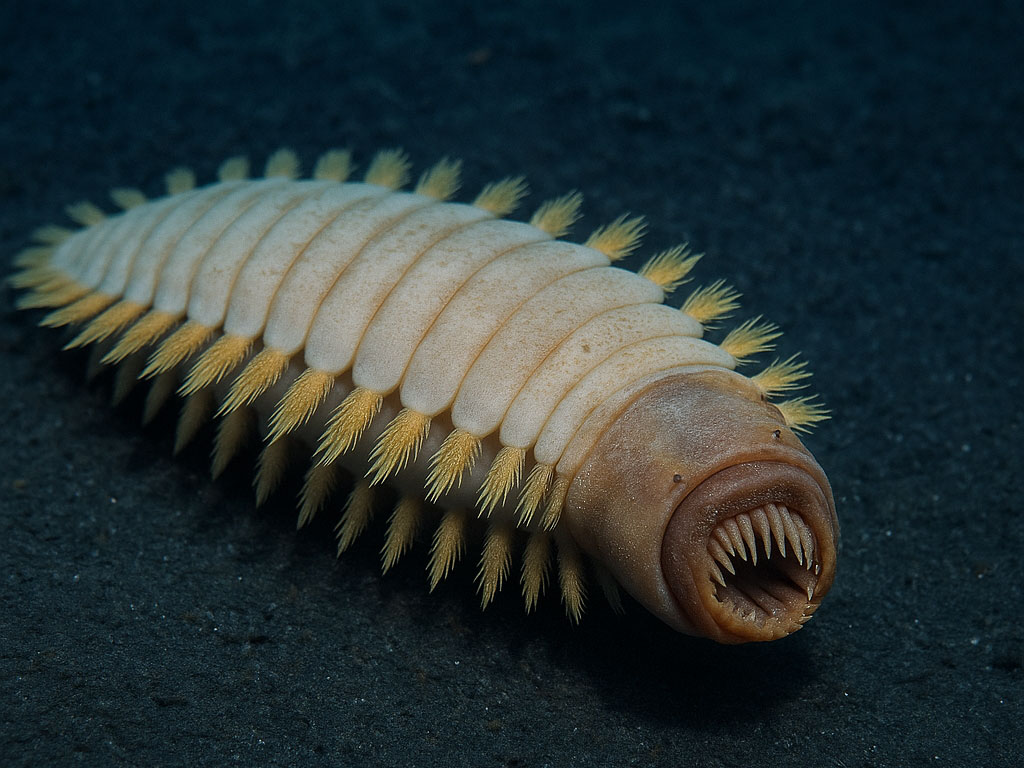
When photos of a strange worm began circulating on Facebook, people assumed it was another deep-sea hoax. But the creature is real. Meet Eulagisca gigantea, the Antarctic scale worm — an animal that looks like it crawled out of a Ridley Scott storyboard.
A Worm That Looks Like It Came From Space
The Antarctic scale worm was first described back in 1939 by zoologist Charles Monro, but it rarely makes headlines outside marine biology circles. That changed when high-resolution photos resurfaced online, showing a creature with a flattened, armor-plated body and what appears to be a mouth full of sharp teeth.
The worm is actually far less menacing than it looks. It lives deep in the Southern Ocean, around 500 meters below the surface, and measures only about 20 centimeters long (roughly eight inches). That’s large for a marine worm, but not “giant monster” territory.
Its bristled sides shimmer with golden fibers, while overlapping scales called elytra protect its back — a design that looks more like intricate jewelry than horror fiction. The worm can also turn its throat inside out, revealing a jawed feeding organ that inspired comparisons to the “Xenomorph.” When it’s not eating, that pharynx retracts neatly inside the body.
Built to Survive the Deep
Living in the frigid Antarctic deep sea requires some clever features. There’s no sunlight, limited food, and pressure that would crush most surface life. The worm’s body plan reflects those conditions.
Its flat shape and plates may help it slide across sediment while resisting pressure. The bristles probably play multiple roles — locomotion, sensing vibrations, and maybe even warding off predators. Scientists believe E. gigantea is a predator or scavenger, feeding on small animals or bits of organic material that drift to the ocean floor.
The Science Behind the Sensation
Despite its online fame, very little is known about this species. Only a handful of specimens have ever been collected, and most of what we know comes from museum samples rather than live observation.
Researchers are interested in Eulagisca gigantea because it offers clues about how complex life adapts to extreme cold and pressure. Studying such species helps scientists understand the biodiversity of Antarctica’s seafloor — a region that remains one of the least explored ecosystems on the planet.
As deep-sea research advances, this worm might even provide insight into biomimicry — how natural adaptations could inspire new materials or robotics designed to operate under pressure and low temperature.
What Social Media Got Wrong
The Facebook posts that made the worm famous were only half right. Yes, E. gigantea is real, and yes, it has those incredible jaws. But no, it doesn’t grow to half a meter or devour large prey. The largest confirmed specimens top out around 20 centimeters, and scientists have no direct evidence of it attacking anything big.
It’s also not newly discovered — it has been in taxonomy databases for decades. The viral descriptions simply recycled old photos and added a horror-movie script on top.
Still Fun to Share
Even if the viral story was exaggerated, it accomplished something useful: it reminded millions of people that our planet still hides alien-looking species in plain sight. For biologists, the Antarctic scale worm is more than clickbait. It’s a snapshot of nature’s creativity — a small but striking creature that has mastered survival in one of Earth’s toughest environments.
Filed in . Read more about Animals, Nature and Worms.








